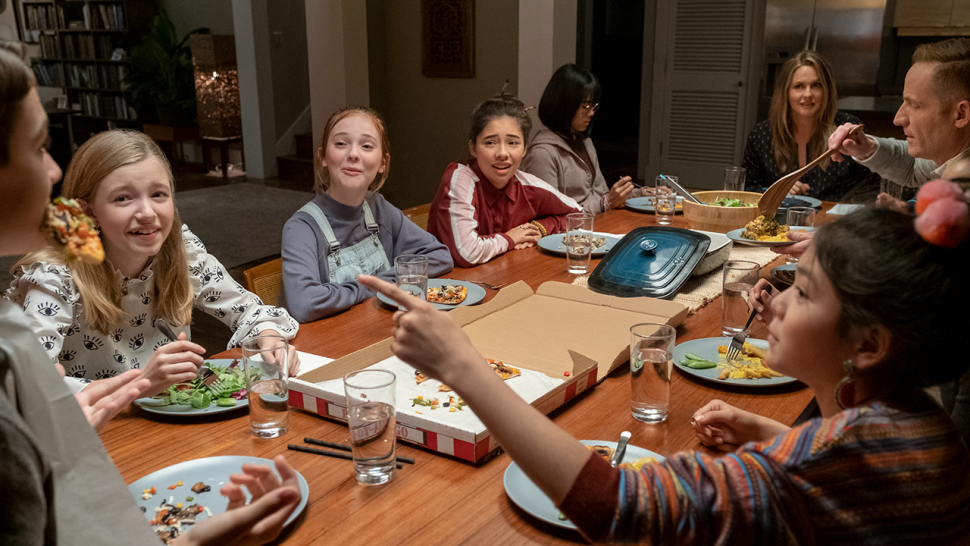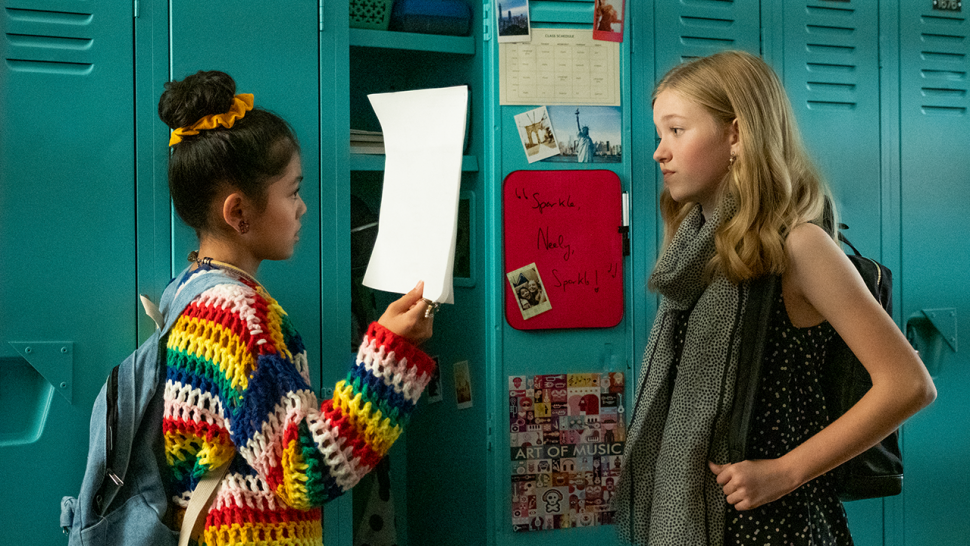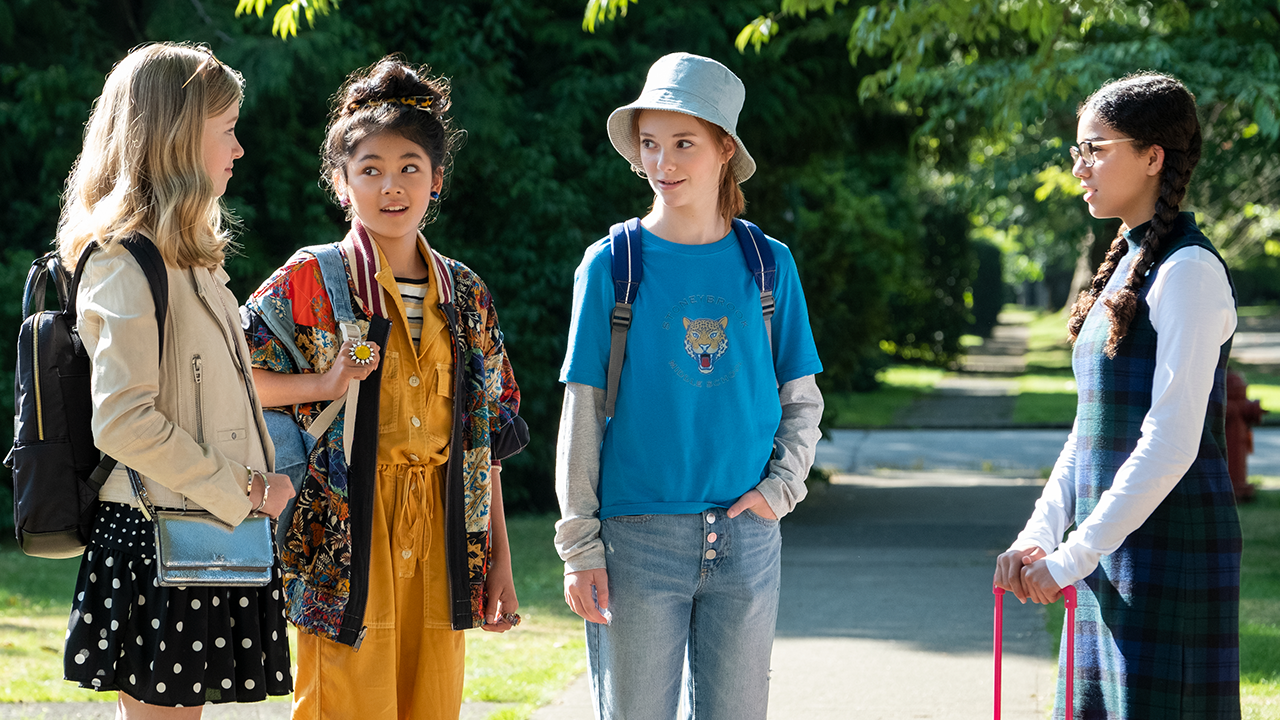Spoiler alert! Do not proceed if you have not watched Netflix's The Baby-Sitters Club. Minor spoilers ahead.
The new generation of The Baby-Sitters Club is here for all your baby-sitting needs!
Recommended Videos
Netflix's modern-day adaptation of Ann M. Martin's beloved novels reintroduces cherished characters Kristy (Sophie Grace), Claudia (Momona Tamada), Stacey (Shay Rudolph), Mary Anne (Malia Baker) and Dawn (Xochitl Gomez), for today's world -- complete with cellphones, social media and even a little dose of Queer Eye. Like the books, which spawned a '90s movie and TV series, the latest iteration zeroes in on topical issues such as divorce, gender identity, health, family hardships, racism and, of course, boys. Plus, you can't forget homages to Baby-Sitters Club iconography, like the official BSC phone.
"It felt like an exciting time to bring them into the present day," executive producer and showrunner Rachel Shukert tells ET. "I had been obsessed with these books as a kid. It was a dream come true to adapt them. Somebody was like, 'You want to do this thing that was sentimental to you growing up?' Of course I do!"
"I wanted to adapt this formative period, but it also felt like an opportune moment because these books are so much about decency, inclusivity and values about being a good citizen, a caretaker, someone other people can count on and a good friend," she continued. "All of this felt like really important models for this time. It's a world that I wanted to be transported to again, and I think a lot of people felt the same way. I feel girls need more stuff made for them."
In ET's wide-ranging conversation with Shukert, she opens up about modernizing The Baby-Sitters Club for Gen Z, Easter eggs and plans for a season 2. (Fingers crossed!)
ET: Were there elements of the TV series and the movie from the '90s that you took from, or did you focus mostly on the books?
Rachel Shukert: It's truly based on the books more than it is on either of the adaptations. The '90s series goes off in their own direction and the movie has its own storyline that doesn't really appear in the initial books. For me, The Baby-Sitters Club is the books. It's not the HBO series and it's not the movie, so it felt like that was really the text to adapt.
How has the franchise evolved with the times through this new take?
It's always an interesting exercise to take characters that existed in one time and ask, who would they be now? And they're not that different. They're into different things. They read different books. They're into slightly different fashion or music, but the essence of who each of those girls are has not really changed. Mary Anne is still shy, philosophical and a little bit insecure and sensitive. Dawn was the one that was sort of brought into the present day the most in terms of rejiggering her interests a little bit. In the books, Dawn is supposed to be this sort of archetype of California girl -- a blonde surfer girl who cares about saving whales. Who is that person in the present day? She's political and more of an activist for the causes she believes in. Kristy is the one with all the ideas and needs to be heard. I think the times have caught up to Kristy a little bit in terms of being a girl who's in charge. It was a little less normal in the '80s, and I think this allows the character to lean into her vulnerability a little bit more, because it's not so weird that she's a girl in an authority position. Stacey, who has interests in math, is also very into fashion but also is into STEM [science, technology, engineering and mathematics]. We just amplified that.

At the heart of The Baby-Sitters Club are the five girls and their friendships. How did you find these five relative newcomers to fill the shoes of the iconic characters they play?
We were so lucky to have Danielle Aufiero and Amber Horn, the casting directors. I cannot say enough amazing things about them; they were just unbelievable. They knew exactly what we wanted and they were tireless in finding these girls. What I really wanted was to find girls who spoke to the essence of these characters just being themselves, and they would inform the characters. We also really wanted girls who felt fresh and natural. There's this "unstudied-ness" about the way that they perform that I think is really special. But we also really needed to find girls who felt like they would be friends with each other. None of them knew each other starting this, and they are now all best friends. They really complement each other in real life and onscreen the way that the girls in the books do. We had over 2,000 girls [audition], but these five really were special, clicked and felt like they were The Baby-Sitters Club.
Which character was toughest to cast?
Kristy was hard because you need someone who's very strong and very smart and very sure of herself, but also can tap into a certain vulnerability. She's a very layered character, so finding an actress that age to reach all those colors was the tough part. Sophie was a real find. She had done maybe a commercial prior to this, and she's such an unbelievable actress. When we found the one for all of them, it wasn't a difficult decision.
What issues or topics did you feel were important to address in this first season?
A big topic at that age is identity: Why am I like that? I don't want to be like that. I want to be as competent as I feel inside and I don't know why I can't project that to other people. So how do I do that? How do I find my voice? That's the question of identity, as much as the question of sexual identity or gender identity, or learning about the history of your family. What is the space between who I am right now and who I want to be? And what space do I want to live in? For me, inclusivity [was another important thing]. The girls are different, but they're still very good friends. It was important that people talk about Claudia as being an iconic Asian American character because there weren't many, but she was also cool and aspirational. And Jessi Ramsey, who's African American and comes in later in the series, she is an example of representation at a time when representation was not a concept that we had.
In episode 4, Mary Anne stands up for Bailey, the kid she is baby-sitting and who identifies as transgender, when the doctors make a mistake about their gender identity. Why was it important to include that scene?
I truly want to encourage inclusivity. Trans kids exist and they deserve to see themselves represented in media and they deserve to feel seen. I think representation in media is such an important step towards everything, you know? That's something that is important to me, is to make kids feel seen and feel like they're a part of this too. I don't know that a lot of kids necessarily see themselves on television a lot of the time. In terms of gender identity, this generation of kids just get it. It's not as complicated as adults necessarily make it. What I liked about that episode is it had a real simplicity in how Bailey thinks about herself and how Mary Anne gets it. It's very cut and dry. It's pretty simple, actually.
Boys orbit around the girls just by nature of where they are in their lives, as they're all forming their identities. But they were always there to support the girls' narratives and not the other way around. How did you maintain that balance?
I think at this age, most of your romantic relationships are really about learning about yourself, about who you like, about how you want to be treated. That's the kind of relationship that you want to have because you're not, like, settling down and getting married when you're 13. They're just part of your own self-discovery, and in a lot of ways, they can seem extremely important and all-consuming; it's another step on your road to becoming the person that you want to be. We tried to present [the boys] that way. They're people also and they can relate to girls as people, and I liked that.
I liked all of the romantic-ish relationships on the show -- they don't pair off in any kind of real way -- but they're friends, they have common interests. Logan and Mary Anne, they do the play together, Trevor and Claudia are very into art and can talk about it in an interesting way. You can't really have a relationship with the opposite sex -- and the same sex -- without that kind of friendship and understanding, and that more important piece of the puzzle. When you don't have that, you wind up with an episode like "Boy-Crazy Stacey," where she has a crush on the side she has nothing in common with, and she learns something through that. That it's more fun to be with someone you can be yourself around. So I think that was something we wanted to show, but everything is not about the boys. They're sort of an enhancement. They're not the main event.

Are there any homages or Easter eggs to the novels or past versions of The Baby-Sitters Club that we may have missed? Obviously, the iconic phone is pretty spectacular.
The phone, for sure. At one point, we had talked about trying to do some sort of cover of The Baby-Sitters Club theme song, but it didn't come together. Maybe that's something to save for later. In the final two episodes, Paris Magic, which is the play they do at camp, is mentioned by Stacey as a show that's playing on Broadway that she wants to go see. It's not a real play, but it's in the world. We pulled names of characters and things like that from the books, even though they may not necessarily be super important mentions.
There is a wink and a nod to Queer Eye. Was that Netflix being like, "Synergy!"?
(Laughs.) Kind of. Part of the thinking about that was Stacey and Claudia probably watch Queer Eye and it just seemed like a really funny thing to do, especially if you're thinking about what they're watching on Netflix. And of course, they had the idea of putting the music over that montage and we had to do it. I think they're similar audiences. I feel like we'll have some overlap.
In the finale, the club brings in Mallory and Jessi as junior members, which sets up perfectly for a second season. Do you have plans in mind, and what will the BSC look like with two younger members?
It will look a lot the way that the books do because they come in later. That's something I always liked about Mallory and Jessi, is that the first relationship that you have, especially with people that are a little bit older than you are, where you idolize them and hope they think you're cool enough... There's always a little bit of a fire to survive. It's an interesting thing to explore, especially for a character like Mallory, who is the oldest of eight kids. What is it like when she's suddenly the youngest? I also think that Jessi is an interesting character because she's someone who is so focused on ballet -- the way that an athlete is. That's a different kind of character than we've often seen. Somebody who has an eye on the prize. Both of those characters are interesting to explore, with each other and the way they fit into the larger picture of the club, which will be a big part of future seasons, should we be so lucky to get one.
Rachael Leigh Cook played Mary Anne in the '90s movie and mentioned she would like to be back in the world in some fashion. Is that something you would be open to -- bringing back people from past versions -- in the future?
Yeah! She knows how to find me.
The Baby-Sitters Club is streaming now on Netflix.
To stay up to date on breaking TV news, sign up for ET's daily newsletter.
RELATED CONTENT:
Meet the New 'Baby-Sitters Club': Fall in Love With the Netflix Stars
'The Baby-Sitters Club' First Look: Meet Jessi Ramsey and Mallory Pike
'The Baby-Sitters Club' Netflix Reboot Shares First Nostalgia-Filled Teaser Trailer: Watch
Exclusive
Exclusive
Image

Byline
Fri, 07/03/2020 - 10:00